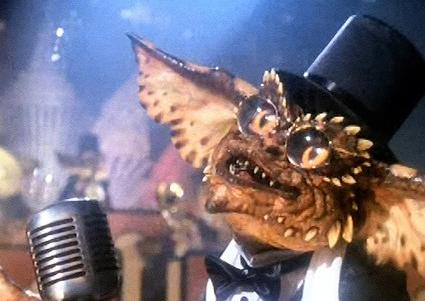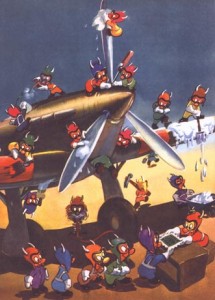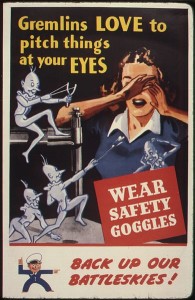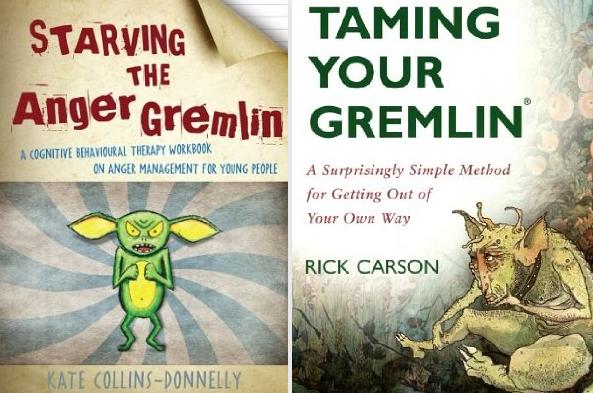Gremlins are one of the most curious of all fairies. They are unquestionably a twentieth-century invention because they are associated with flight: though the question of when are where they originated is controversial. Pilots invoked them to explain freakish mechanical problems on planes and general unexplained happenings. The gremlin was mischievous rather than sadistic. The problem is that when you start messing around with a flight systems or a plane engine things crash. It is all very well the gremlin saying afterwards that he just wanted to stay at home on the runway… Note that a late piece of folklore is that gremlins were frightened of pigeons, much as fairies are frightened of iron.
Home Region: Gremlins like airports and planes everywhere.
Physical Description: As is perhaps to be expected with a new entry to faery there is a great deal of vagueness. However, there is a surprising consistency about the idea that gremlins wear top hats, something without fairy precedence. To his very great credit one top hat appeared in the 1984 film, Gremlins, though bizarrely the planes disappeared.
Earliest Attestation and Etymology: The earliest reference in the Oxford English Dictionary is to 1941 (thought that reference leads back to the Great War): ‘As he flew round, he wished that his instructor had never told him about the Little People—a mythological bunch of good and bad fairies originally invented by the Royal Naval Air Service in the Great War. Those awful little people, the Gremlins, who run up and down the wing with scissors going ‘snip, snap, snip’ made him sweat. But there are claims that gremlin belief dated back into the 1930s or even to the First World War: there is allegedly a poem dating from 1929 (that we’ve not been able to track down unless it is this) and there is certainly a reference from 1938. A couple of points of consensus. First, Gremlins seem to have been a British creation. There are arguments about whether it was the Naval Arm, fliers out of Malta or World War One salts, but there is no question that British fliers were the first to encounter them, though the idea quickly spread through the Allied services of other nations, not least the United States. Second, the name probably means nothing and has been conjured into the air by analogy with Goblin. Gillian Edwards (216) suggests the German word Grämlein (little grief). She notes the adoption of other words such as strafe and blitz in the war years, though these were based on well known German words, which Grämlein is not. Another suggestion connects Gremlin to the British mission in Russia: as the only word that rhymes with Gremlin is Kremlin! Yet another suggestion connects Gremlins to Fremlins a German beer make. The most common suggestion in reference guides is the Old English word gremian, to vex, which would be just dandy had Old English not died out as a language in the twelfth and thirteenth centuries: all those Saxons on their biplanes.
Gremlin Locations: Since a famous episode of the Twlight Zone they are also to be seen on plane wings in flight.
Gremlin Sighting: Gremlin in a Lancaster
Gremlin Story: British Gremlin Poem
Gremlin sayings: ‘Bloody gremlins’, ‘the bloody gremlins did it, Captain’ etc etc
Popular Culture: How could popular culture have ignored the gremlins? Already in 1942 Walt Disney (in an anticipation of his flight to Ireland to study fairies) flew to Britain to see if he couldn’t make a film about this new breed. Gremlins also appeared in various cartoons and children’s books including, for example, E.P.Dutton’s Listen Hitler The Gremlins Are Coming (1943), which is all rather curious given that the Gremlins seem to have been working for the Nazis. Roald Dahl’s first children’s book was entitled The Gremlins and was released the same year as a tie in for a Disney film that never happened: Dahl tried, to his credit, to connect the story into traditional British lore. There was one Bugs Bunny program from 1943 (Falling Hare) that included the gremlins though. The US government employed gremlins in various health and safety campaigns (see above). Here for the first time there is the idea that gremlins are mechanical rather than simply aeronautical. The next important step for gremlins was the 1963 episode (Nightmare at 20,000 feet) of the Twilight Zone where a very hairy and hatless gremlin does his best to wreck a plane wing. In 1983 the Gremlin returns in Twlight Zone: The Movie, he is now more like a dinosaur than a sasquatch. Last we must mention, of course, Gremlins (1984), a Spielberg produced film: planes were nowhere to be seen though blood was everywhere. Then, if that wasn’t bad enough gremlins were absorbed into pyscho babble. There can be few worse fates for a malicious fairy… I mean they are not supposed to help people!





